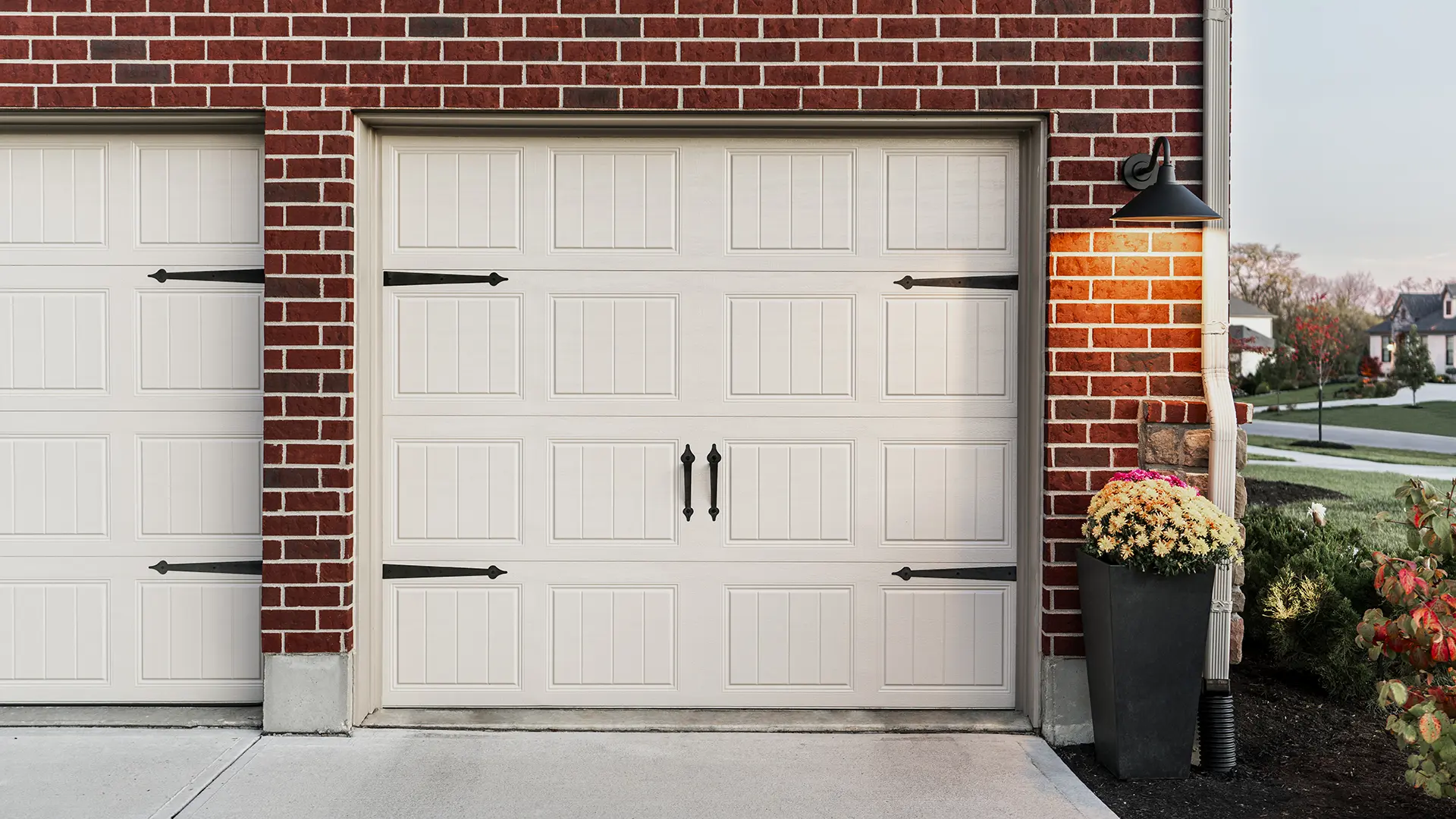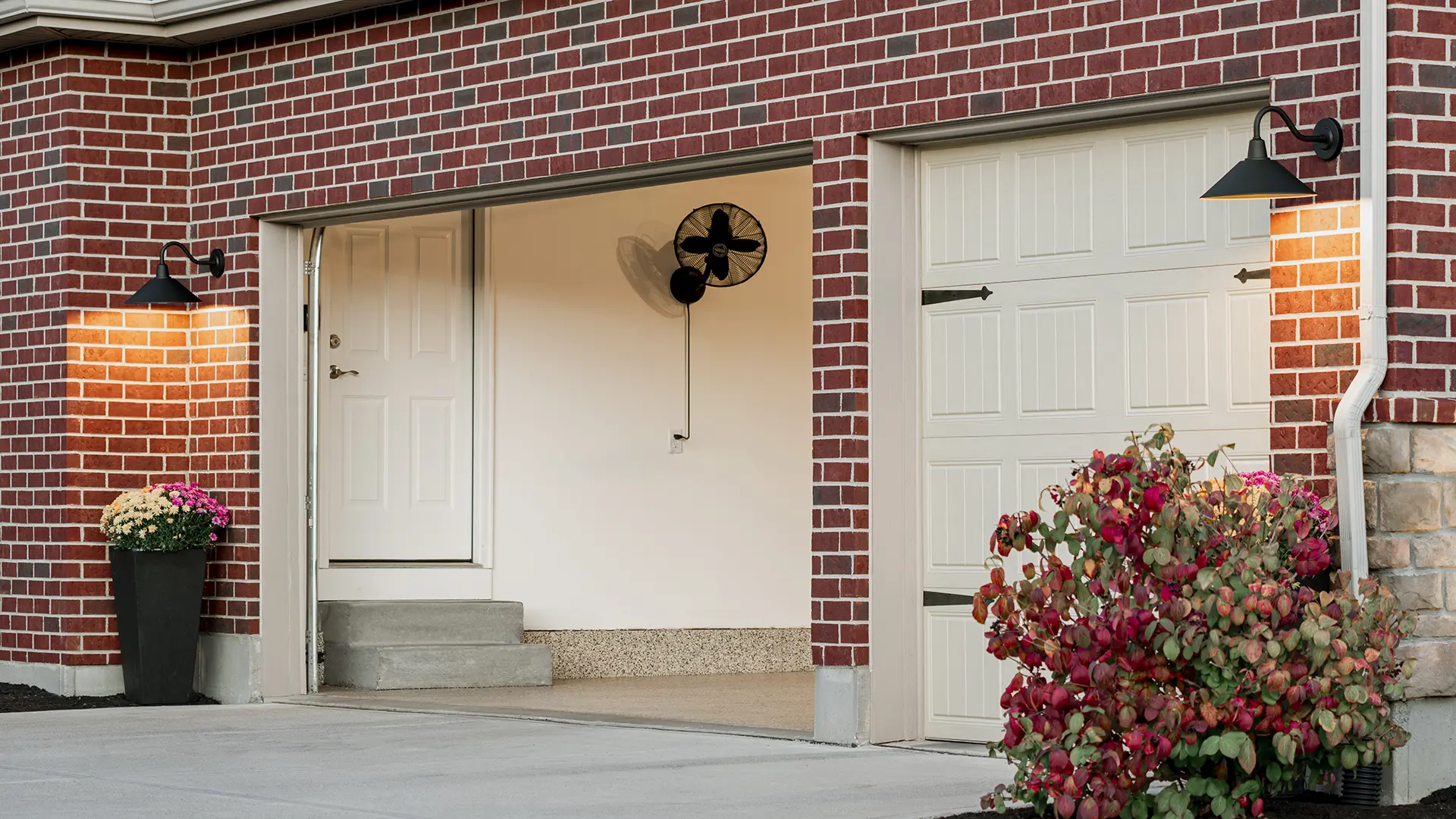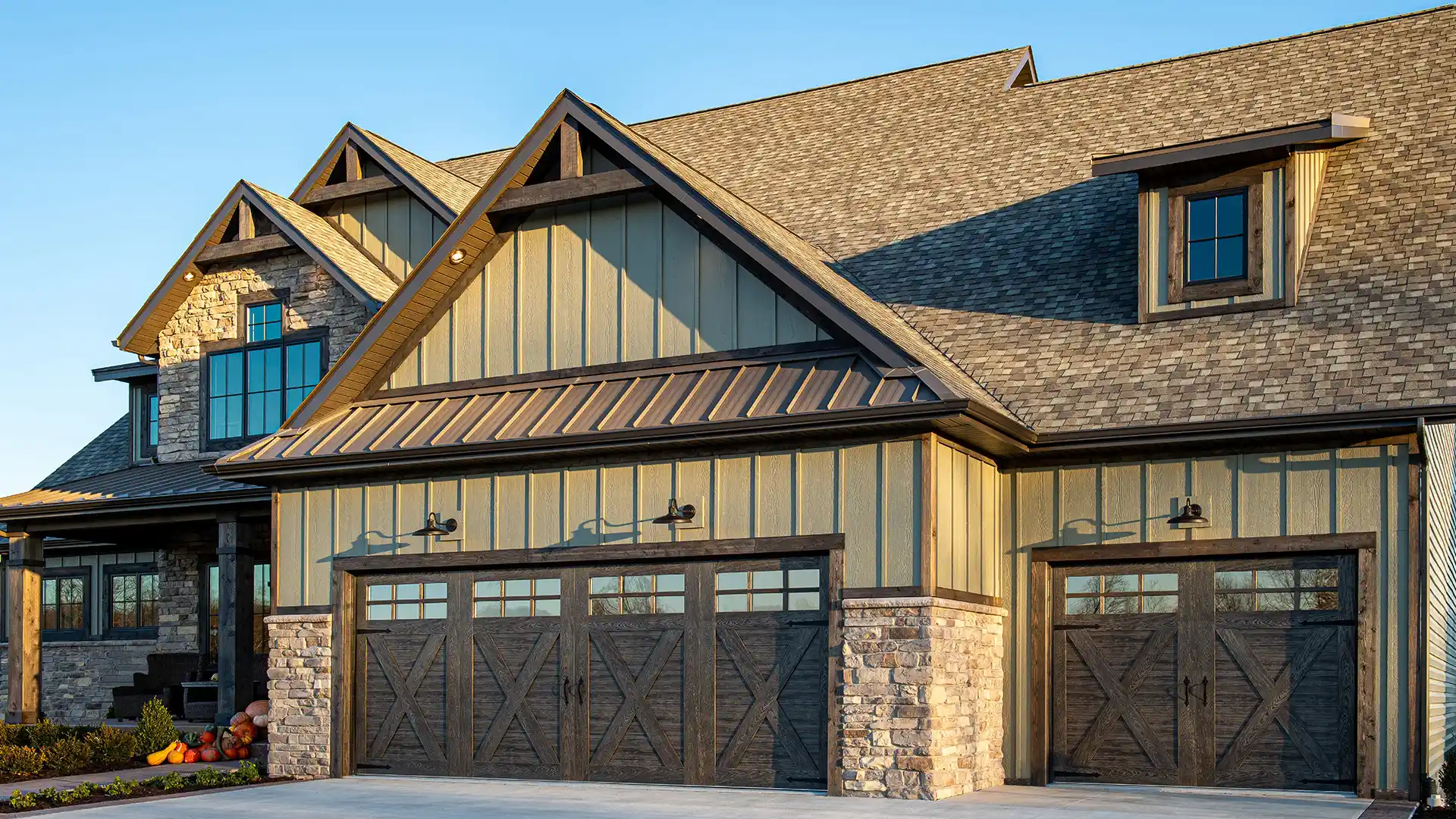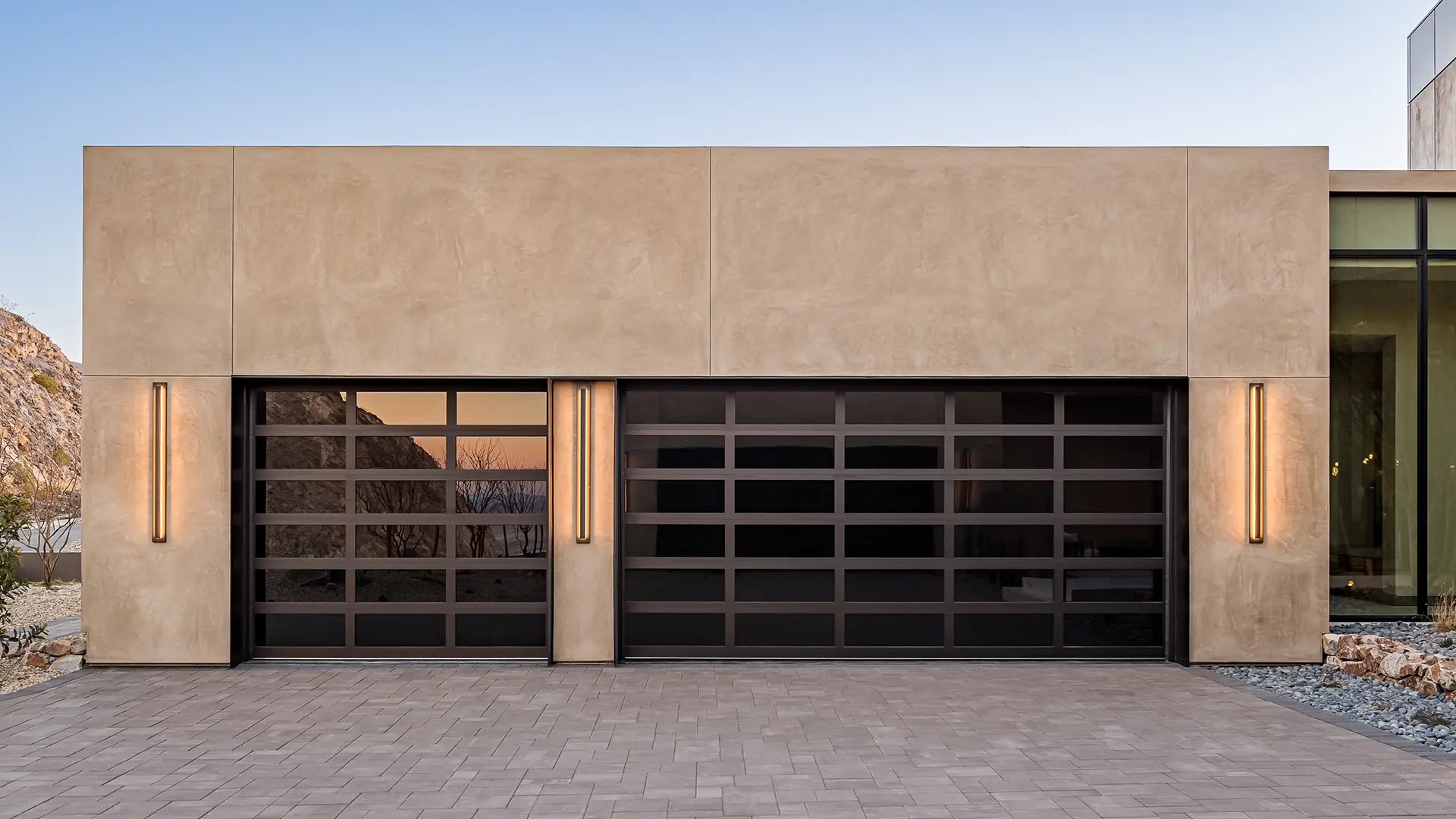First impressions matter, and garage lighting plays a starring role in your home's nighttime appearance. Well-planned exterior garage lighting creates an inviting pathway, adds a layer of security, and elevates the overall look of your property. From traditional coach lights flanking the doors to sleek modern fixtures that cast the perfect glow, the options for illuminating the garage area are endless.
Whether you're updating old fixtures or starting fresh, selecting the right garage lighting combines both practical necessity and visual appeal. This guide will help you navigate through fixture styles, placement strategies, and smart features to create the perfect lighting solution for your home's exterior.
Benefits of Exterior Garage Door Lighting
The benefits of exterior garage lighting extend far beyond the obvious and offer not only practical advantages for homeowners, but an opportunity to add a touch of style and design in an unexpected place.
When it comes to curb appeal, thoughtfully placed exterior garage lighting can highlight architectural details that might otherwise go unnoticed after dark. Wall sconces can cast gentle shadows that emphasize texture on brick or stone facades, while carefully positioned downlights can showcase decorative garage door patterns or trim work. According to recent market analysis, homeowners are increasingly investing in architectural lighting solutions, recognizing its potential to enhance property aesthetics and value.
Visibility and functionality go hand in hand when it comes to exterior garage lighting. Well-placed fixtures ensure safe navigation of your driveway and walkways during evening hours, preventing trips and falls while making everyday tasks like unloading groceries or managing trash bins more manageable. Motion-sensor lights can automatically brighten your path as you approach, combining convenience with energy efficiency.
Perhaps most significantly, exterior garage lighting can play a vital role in home security. The good news is, residential burglaries were down 13% in 2024 from 2023, but until that number is zero, there’s reason for homeowners to stay vigilant. Exterior garage lights are a simple deterrent that works in conjunction with other security measures. The home security systems market, valued at $56.1 billion in 2024, demonstrates how seriously homeowners take protection measures. Motion-activated lights are particularly effective, creating sudden illumination that can startle and deter unwanted visitors while alerting homeowners to movement around their property.
The combination of these benefits - enhanced property design, improved visibility, and increased security - makes exterior garage lighting an essential investment for any homeowner. And as LED technology advances and smart lighting solutions become more accessible, the options for creating both beautiful and useful lighting designs continue to expand.
How Many Lights Do You Need?
Determining the right number of exterior garage light fixtures depends primarily on your garage size and configuration. Let's break it down by garage type:
For a one-car garage, the classic approach calls for two exterior garage lights, positioned on either side of the door. These symmetrical fixtures, typically mounted at eye level or slightly higher, create a balance while framing the door. Most single-car garage doors measure between 8 to 10 feet wide, making this two-light arrangement ideal for even light distribution.
When it comes to two-car garages, two to three exterior garage light fixtures often work best. Install one light on each outer edge, and if there's a significant break or column between doors, add a fixture in this space. For a seamless double door without a break, two larger fixtures on the outer edges usually suffice.
Three-car garages require a little planning to maintain visual balance. Three to four exterior garage light fixtures typically provide optimal coverage. Position lights on both ends and add fixtures between each door section or architectural break. If your three-car garage features a continuous door design, consider using three evenly spaced, proportionally sized fixtures to maintain symmetry while ensuring adequate light.
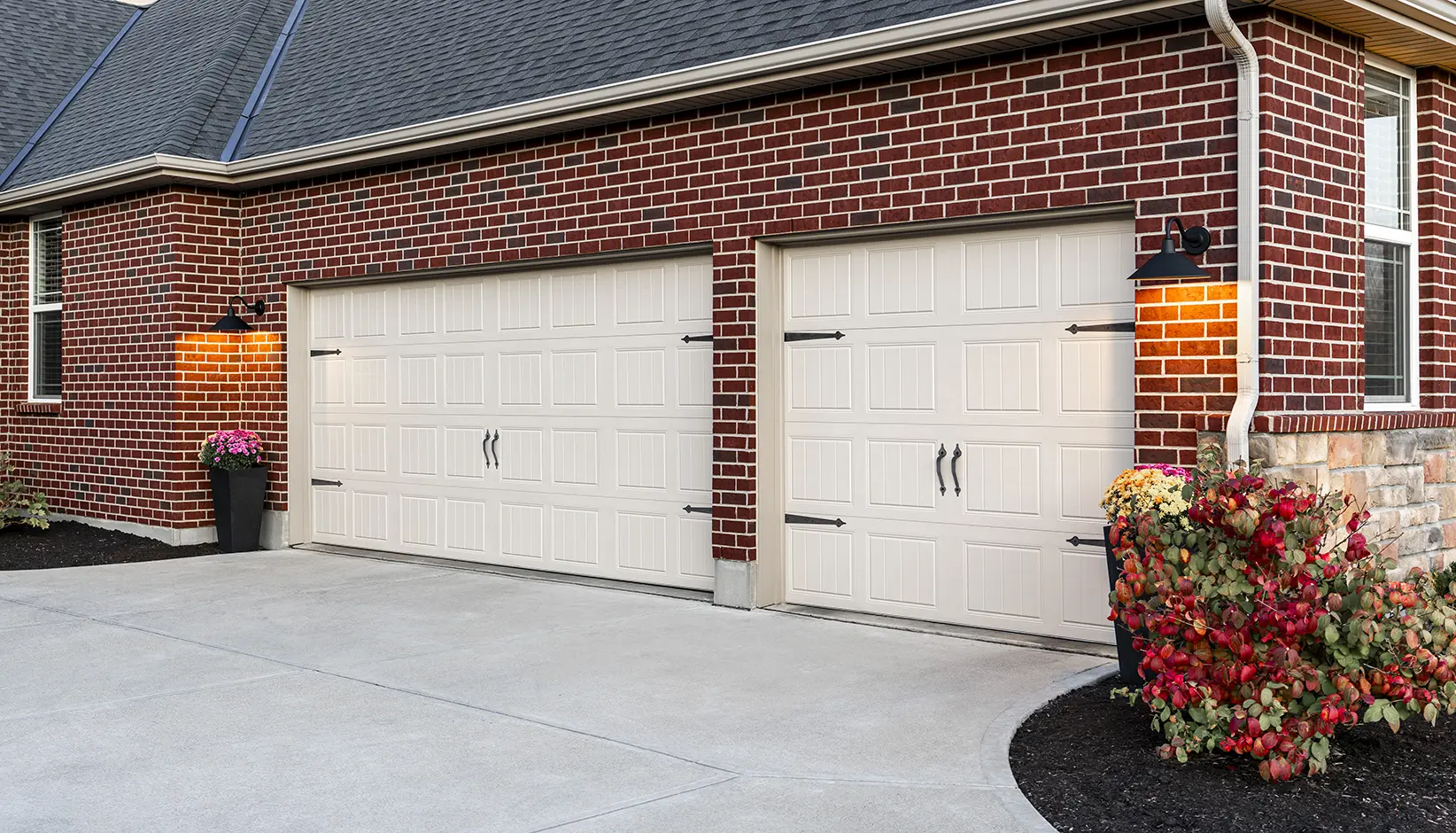
Gallery® Steel doors in Almond
Remember that these are starting points - factors like your home's architectural style, the garage's height, and surrounding landscape features might influence your final configuration. The goal is to create even illumination without dark spots while maintaining visual harmony with your home's exterior.
What Size Should Your Garage Door Lights Be?
Selecting the right size for your exterior garage light fixtures is just as important as their placement. Too small, and they'll look awkward and provide insufficient light; too large, and they'll overwhelm your garage's facade.
Generally speaking, exterior lighting should be one-third to one-fourth the height of the garage door. For single garage doors, multiply the door's height by 0.25 to determine optimal fixture size. For example, if your garage door is 7 feet tall, your exterior garage light fixtures should be approximately 21 inches tall (84 inches x 0.25 = 21 inches). This proportion creates visual balance while ensuring adequate illumination.
Double garage doors require slightly larger fixtures relative to the total height. Multiply the total door height by 0.33. For a standard 7-foot-tall double door, you're looking at fixtures around 27 inches tall (84 inches x 0.33 = 27 inches).
Once you've done these calculations, review the specifications of fixtures you're considering. Look at both the fixture's overall height and width, plus its light output measured in lumens. A fixture's light output should match your calculated size - generally, larger fixtures should provide more lumens. Most manufacturers list recommended mounting heights and coverage areas in their specifications, which can help confirm whether your size calculations align with real-world performance.
Remember that these formulas serve as starting points. Factors like your home's architectural style, the height of your garage, and the distance between your garage and the street might influence your final choice. The goal is to choose exterior garage lighting that looks proportional while providing effective illumination.
Types of Exterior Garage Lighting
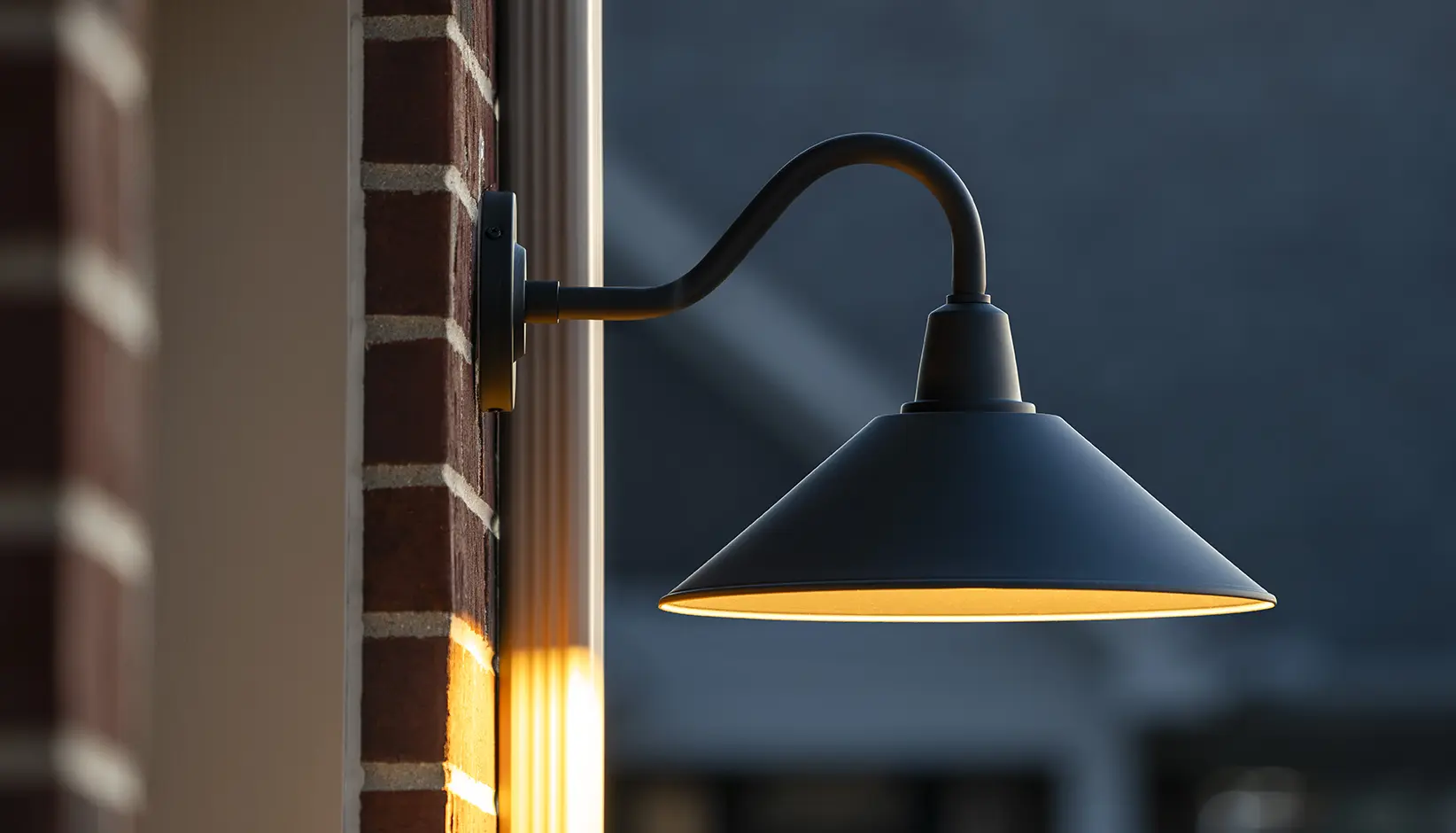
Hunter Fan Skyflow collection
Exterior garage lighting comes in various styles and mounting options, each serving specific purposes while adding distinct character to your home's exterior. Here are some of your main options and how they’re used:
Wall-Mounted Lights
The most common choice for exterior garage lights, wall-mounted fixtures offer versatility and style. Modern options like the Aeronaut Outdoor WeatherMax® from Hunter feature clean lines and durable materials, perfect for contemporary homes. For a more traditional look, the Cassius Outdoor WeatherMax®, also from Hunter brings classic charm and would look perfect on a farmhouse style home.
Traditional lanterns remain a popular exterior garage lighting idea, offering timeless appeal that complements various homes. These fixtures typically feature clear or seeded glass panels and can range from simple colonial designs to ornate Victorian-inspired pieces. Many homeowners opt for oil-rubbed bronze or black finishes for a classic look, while others choose brushed nickel or copper for a more contemporary feel.
Sconces provide another versatile wall-mounted option. Up-light sconces cast a gentle glow upward, highlighting architectural features, while down-light sconces focus light on entryways and walkways. Some sconces offer both up and down lighting, creating interesting shadow patterns while providing practical light. Wall-mounted floodlights offer broader coverage, making them ideal for larger areas or security purposes.
Ceiling-Mounted Lights
For covered entryways or garage overhangs, ceiling-mounted fixtures provide stylish overhead lighting solutions. The Skyflow Outdoor Flush Mount from Hunter offers a sleek, modern profile that works well in contemporary settings, while the Mill Valley Outdoor Flush Mount, also from Hunter, adds a traditional look to your garage exterior. Flush-mount fixtures sit close to the ceiling, making them perfect for areas with limited headroom, while pendant lights can add dramatic flair in spaces with higher ceilings.
Post Lights
These freestanding fixtures serve dual purposes: illuminating your driveway and adding interest to your landscape. Traditional lamp posts bring a classic look and provide consistent lighting along longer driveways. Modern bollard lights offer a contemporary alternative, with clean lines and focused downlighting that minimizes light pollution. Post lights work particularly well when spaced evenly along driveways or pathways leading to your garage, creating an inviting approach while ensuring safe navigation.
Landscape Lighting
Complementary landscape lighting can elevate your garage's overall appearance. Well lights installed in the ground can wash your garage walls with a subtle upward glow. Path lights along walkways provide safe passage while adding layers of light to your outdoor space. Strategic spotlights can emphasize property details or illuminate surrounding landscaping, creating depth and dimension in your nighttime exterior design.
When selecting exterior garage light fixtures, consider how these different types can work together. For example, wall-mounted sconces might provide primary illumination, while landscape lighting adds depth and ambiance. Post lights can guide visitors along your driveway, and ceiling-mounted fixtures can illuminate covered areas. The key is creating layers of light that serve a purpose while maintaining a cohesive design that complements your home.
Tips for Choosing the Right Light for Your Garage Exterior
Choosing the right exterior garage lighting can feel overwhelming with all the options available. But by focusing on a few key elements, you can select fixtures that make your home more secure, welcoming, and energy efficient. Here's what to consider when making your selection:
Light Temperature
The color temperature of your exterior garage lights can really impact the overall look and effectiveness of the lights. Warm white bulbs (less than 3000K) create a welcoming, cozy atmosphere that complements brick and wood facades. These temperatures work particularly well with traditional architecture and warm-colored exteriors. Cool white bulbs (4000K+) offer crisp, clean light that suits modern homes and provides clearer visibility. Daylight bulbs (5000-6500K) deliver the brightest, bluest light and although they’re excellent for security purposes, they can appear harsh in residential settings and might disrupt your home's evening ambiance.
Brightness and Glare Control
When it comes to exterior garage lighting, brighter isn't always better. Aim for fixtures that provide between 800 and 1200 lumens per light for standard residential garages. Position lights to illuminate your target areas without creating harsh glare that could temporarily blind drivers or pedestrians. Consider fixtures with diffused glass or built-in glare shields, especially if your garage faces neighboring properties. Remember that multiple moderate-brightness fixtures often provide better overall illumination than a single ultra-bright light.
Motion Sensors
Installing motion-sensing exterior garage light fixtures offers multiple advantages. Beyond the obvious security benefits of deterring unwanted visitors, motion sensors can reduce energy consumption by up to 75% compared to lights left on continuously. Look for fixtures with adjustable sensitivity settings to prevent false triggers from small animals or moving branches. Many modern motion sensor lights also include customizable time delays and ambient light sensors, ensuring they only activate when needed.
Professional Installation
While some homeowners might be tempted to tackle exterior garage lighting installation as a DIY project, professional installation often proves worthwhile. Licensed electricians understand local building codes, proper weatherproofing techniques, and optimal placement for maximum effectiveness. They can ensure your new fixtures are correctly grounded, sealed against moisture, and positioned at the ideal height and angle. Professional installation also typically includes proper wiring for motion sensors and timers, reducing the risk of electrical issues down the line.
The right exterior garage lighting enhances both the security and style of your home. As you plan your lighting upgrades, consider consulting a Clopay dealer about coordinating your garage door design with Hunter Fan’s collection of exterior garage lighting ideas. Together, these elements create an inviting, well-lit entrance that adds value and character to your home.
Frequently Asked Questions About Exterior Garage Lighting
Q: How much should I budget for exterior garage lighting?
A: Quality exterior garage light fixtures typically range from $50 to $300 per fixture, depending on style and features. Factor in professional installation costs, which can range from $200-$500 for a standard setup.
Q: Can I install exterior garage lights myself?
A: While DIY installation is possible, we recommend professional installation to ensure proper wiring, weatherproofing, and compliance with local codes. This is especially important for motion-sensor lights and new wiring installations. Q: How long do exterior garage lights last?
A: Modern LED exterior garage light fixtures can last 15-20 years with proper maintenance. The actual bulbs can operate for 25,000-50,000 hours, depending on usage patterns and quality.
Q: What maintenance do exterior garage lights require?
A: Regular maintenance includes cleaning the fixtures (2-3 times per year), checking for loose connections, and ensuring weatherproofing seals remain intact. Replace any clouded or damaged glass promptly.
Q: Will bright garage lights attract insects?
A: Warm white bulbs (2700-3000K) attract fewer insects than cool white or daylight bulbs. Using LED bulbs and properly sealed fixtures also helps minimize insect issues.
Q: How can I reduce my energy costs with exterior garage lighting?
A: Choose LED fixtures, install motion sensors or timers, and use appropriate wattage for your needs. Many homeowners save 30-75% on lighting costs by upgrading to modern, energy-efficient systems.

